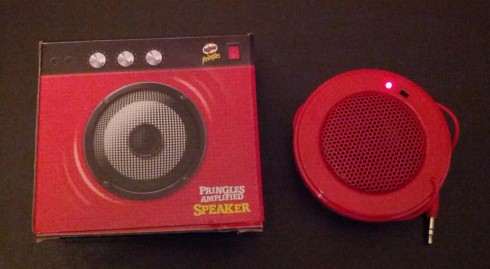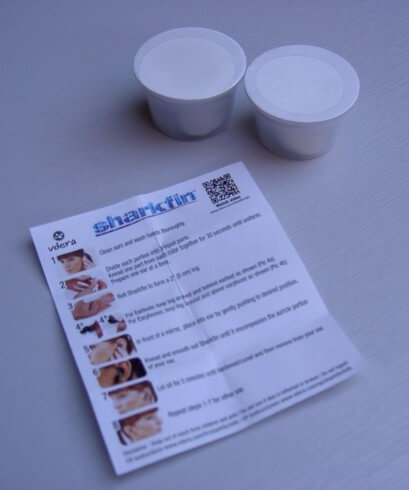Moxytronix‘s CordCruncher earbud headphones are the latest attempt to defeat that bane of modern life, knotted and twisted audio cords. These tangle-free headphones solve the problem by using a secondary rubber tube to retract and hold the cords when not in use. Cunning.
The headphones come in a small pack, with three pairs of different-sized interchangeable earbuds. I would imagine that anyone who is used to wearing earbuds will have no problems here. The CordCrunchers are available in a range of colours, included a very hot pink which the photos below completely fail to reproduce – it’s a gamut thing.
The picture above shows the CordCruncher in the retracted state with all the cord inside the rubber tube – it’s only about 18″ long. To use the headphones, hold the jack end and pull on the earbud cords, drawing the leads out of the tube to a full length of over 3 feet. The picture below shows the Crunchers with the cords extracted. The zigzag gives a clue as to how the cord “crunches” up inside the tube.
To pack the earbuds away, hold the jack in one hand and then pull the black collar away from the jack. The rubber tube is latex and stretches enormously until the cables are back inside. Gently relax and everything concertinas back up to the original length, tucking all the cables away. It’s not that easy to explain, so here’s a video.
After using the CordCrunchers for a week or two, I can confirm that they actually work and tangled cords are a thing of the past. I carried these round in my sports bag during testing and I never had a single tangle. Yank them out, stick them in your ears and get to work.
Sonically they’re not the greatest earbuds ever and in comparison with Sennheiser CX-300s, the sound is muddy and poorly defined. To be fair, the CX-300s cost about twice the price and audio fidelity isn’t the main reason for buying the CordCrunchers. However, I hope that Moxytronic do consider a higher end model in the future for those who demand more.
Pricewise, they’re around US$25 and here in the UK, they’re being sold by Advanced MP3 Players for a £19.99 in a range of four colours (pink, green, black and blue).
Finally, my six year-old daughter thought they were cool, which is probably more to do with the pinkness than anything else.
Thanks to DAD and Advanced MP3 Players for providing the CordCrunchers for review.




 Once a pon a time a number of years ago I went through a period of several years where I spent a fair amount of money on compact discs. Those days are long gone and have been for some time.
Once a pon a time a number of years ago I went through a period of several years where I spent a fair amount of money on compact discs. Those days are long gone and have been for some time. Audio Evolution Mobile 1.7.2 is a powerful multitrack audio recorder for Android that is somewhat reminiscent of Adobe Audition 1.5 in both form and function. Priced at $7.45 US, the app is a real bargain for anyone looking to do serious multitrack audio recording and editing on an Android tablet or smartphone.
Audio Evolution Mobile 1.7.2 is a powerful multitrack audio recorder for Android that is somewhat reminiscent of Adobe Audition 1.5 in both form and function. Priced at $7.45 US, the app is a real bargain for anyone looking to do serious multitrack audio recording and editing on an Android tablet or smartphone.




